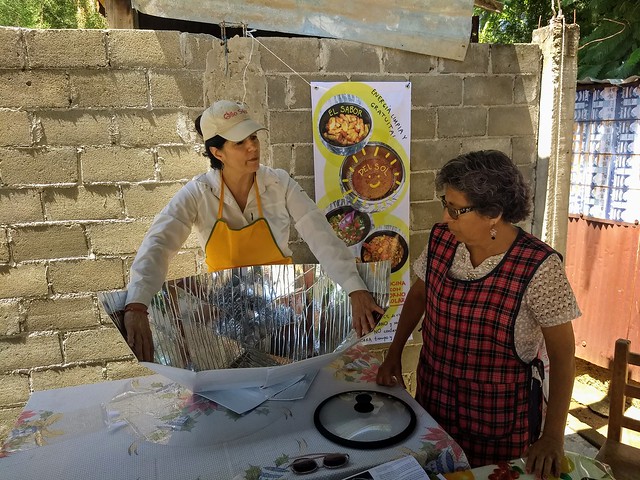Solar Cookers Produce More Than Food for Mexican Women

VILLA DE ZAACHILA, Mexico, Oct 30 (IPS) - The sun's rays are also used to cook food and thus replace the burning of firewood and gas, improve the health of local residents and fuel the energy transition towards the use of renewable sources - the objectives of an enterprise in the southern Mexican state of Oaxaca.
Sponsored by the Washington-based non-governmental organisation Solar Household Energy (SHE), women from 10 communities have received some 200 solar cookers, including residents of the municipality of Villa de Zaachila, which has about 43,000 inhabitants.
Solar cookers function as a sort of greenhouse that cooks food by concentrating heat. They are are low-tech devices that use reflective panels to focus sunlight on a pot set in the middle.
The pot "uses as fuel the sun's rays, which are totally free, are 100 percent clean, do not emit carbon dioxide and thus promote the energy transition. The technique foments women's empowerment, makes it possible to cook healthy foods and keeps women from inhaling smoke from burning firewood," explains Margarita Christlieb, SHE's representative in Mexico.
In 2004, the first attempts began to distribute solar cookers in Oaxaca. In 2008, activists created the initiative "Solar energy for mobile food stalls in Mexico", sponsored by three Swiss institutions: the Geneva city government, the SolarSpar cooperative and the non-governmental organisation GloboSol.
In 2016, SHE initiated a pilot project in indigenous communities to evaluate how well the solar cookers had been accepted.
The four-litre pot, which has a useful life of between five and 10 years, costs about 25 dollars, of which SHE covers half and the beneficiaries the other half.
Some 19 million of Mexico's 130 million people use solid fuels for cooking, a practice that led to an estimated 15,000 premature deaths in 2016 from the ingestion of harmful particles, according to the National Institute of Statistics and Geography (Inegi).
The main material consumed by 79 percent of these households is LPG, followed by wood or charcoal (11 percent) and natural gas (seven percent).
In Oaxaca, gas and firewood each account for 49 percent of household consumption, with other fuels making up the rest. It is one of the three Mexican states with the greatest energy poverty, defined as more than 10 percent of a household's income spent on energy.
The promoters of the initiative are betting on expanding the delivery of the devices. But to do so they need government and private support, as part of a broader policy fomenting the use of solar energy.
© Inter Press Service (2019) — All Rights Reserved. Original source: Inter Press Service
Where next?
Browse related news topics:
- Trade, Economy, & Related Issues
- Causes of Poverty
- Non-governmental Organizations on Development Issues
- Free Trade and Globalization
- Women’s Rights
- Environmental Issues
- Biodiversity
- Nature and Animal Conservation
- Climate Change and Global Warming
- Human Population
- Consumption and Consumerism
- Sustainable Development
- Energy Security
- Democracy
- Global Financial Crisis
Read the latest news stories:
- UN Chief's Ramadan Solidarity Visit Revives Rohingya Refugees Hope Saturday, March 15, 2025
- ‘Time for bold moves’: UN urges inclusive transition as Syria marks 14 years of conflict Saturday, March 15, 2025
- ‘Is this just a long, beautiful dream?’: Syrian filmmaker Waad Al-Kateab on her country’s future Saturday, March 15, 2025
- Trump, Democracy and the U.S. Constitution Friday, March 14, 2025
- Is UN in Danger of Losing its Battle for Gender Equality? Friday, March 14, 2025
- ‘Without us, there is no future’: Youth take over UN Women’s Commission Friday, March 14, 2025
- No food deliveries to Gaza as border closures continue Friday, March 14, 2025
- World News in Brief: Fresh fighting in eastern DR Congo, global trade update, elections in CAR, Pakistan train hijack Friday, March 14, 2025
- Reject bigotry and discrimination, UN chief says, urging everyone to combat Islamophobia Friday, March 14, 2025
- Iran protests: Human Rights Council probe condemns online, app-based repression Friday, March 14, 2025
Learn more about the related issues:
- Trade, Economy, & Related Issues
- Causes of Poverty
- Non-governmental Organizations on Development Issues
- Free Trade and Globalization
- Women’s Rights
- Environmental Issues
- Biodiversity
- Nature and Animal Conservation
- Climate Change and Global Warming
- Human Population
- Consumption and Consumerism
- Sustainable Development
- Energy Security
- Democracy
- Global Financial Crisis
